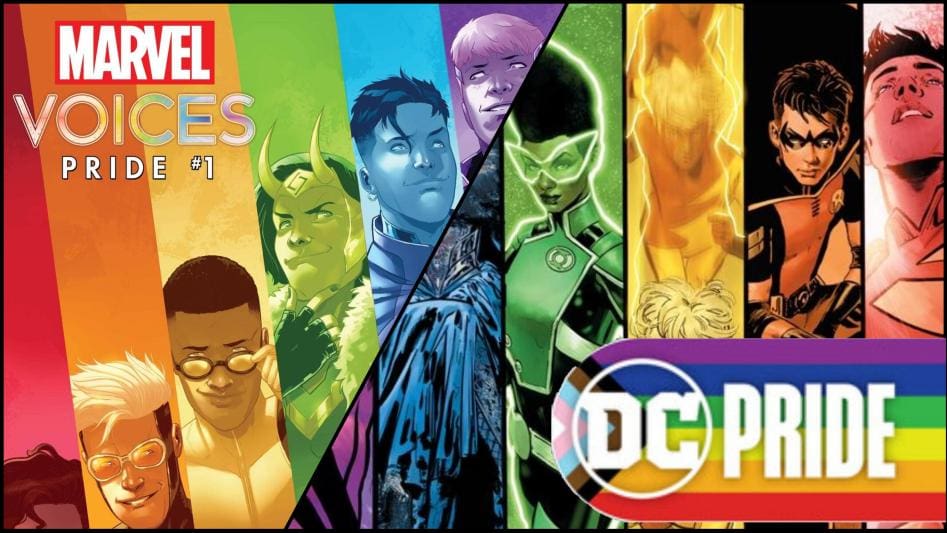Share this

When Stan Lee and Steve Ditko created Spider-Man in 1962, they drew him in a costume that covered his body from head to toe. That way no matter what race, gender or sexual identity someone is, they could see themselves as Spider-Man.
Over the years the comic book fanbase has been growing and with that comes more people to represent. This includes people of color, with different religions, and that are part of the LGBTQ.
Comic book companies have been using queer characters and themes for years, but were they using them correctly?
Justin Mousseau is asexual comic book TikToker with over half a million followers. Mousseau has been a fan of comic books ever since he was a kid in the 90s.
‘I Never Thought This Would Happen’ – A ‘Ms. Marvel’ Conversation
“I am grateful that we are no longer in the era like the mid-2000s. Where characters were gay as a punchline.” Mousseau said. “It rings really cheap and hollow to go back and have a character be gay or feminine, and that was the joke or the entirety of the story.”
An example of this is in Peter David’s Supergirl #79 in 2003. Superman is exposed to pink kryptonite. This kryptonite made Superman give Lois Lane the cold shoulder, and give all of his attention to his best pal Jimmy Olsen. The “joke” of this story is that Superman is flirting with a man.
But have comic books changed since then?
The LGBTQ community has grown in the comic fanbase and companies like DC and Marvel have taken notice. To represent this community DC and Marvel have been taking pre- established characters and have them come out as queer. Or they just made new characters altogether. Some examples include Iceman coming out as gay and Tim Drake (The Third Robin) coming out as bisexual. Now they have introduced characters like Jonathan Kent (Superman) who is bisexual and America Chavez who is lesbian. However, some comic book readers aren’t okay with that.
When Tim Drake came out as bisexual last year, the internet couldn’t be more divided. Fans of the character argued on TikTok, Instagram, and Twitter whether this change was necessary, forced, or if it just ruined the character altogether. However, TikToker and screenwriter Danielle Silverstone says there was no change at all.
“You don’t have to necessarily say that a character is queer,” Silverstone stated, “but you can acknowledge it.”
Tim Drake has been written throughout the years as possibly being bisexual with Conner Kent (Superboy). In 2018, writer Judd Winick tweeted about the relationship between Tim and Conner in his 2003 run of Titans/Young Justice: Graduation Day, stating, “I saw this as an opportunity for them to both come out of the closet.”
“If he (Tim Drake) was meant to be a straight character, then they (DC Comics) would have said that.” Silverstone said. “Straight is not the default. If you do not specify a character’s sexuality, why are people assuming they are straight?”
A common argument from fans against LGBTQ representation is that comic books are for kids, and sex shouldn’t be a topic they are exposed to.
Michael Simeon is a social media influencer that uses his platform to speak out for the LGBTQ community and for people of color. “Who said anything about sex? Being queer is more than about sex.” Simeon said. “Being queer can dictate who you choose or choose not be friends with, what your interests are, what you may gravitate towards, what spaces may feel or not feel comfortable entering, what policies you support in a politician, it determines a lot of your mindset.”
An example of this is Iceman. He was created in 1963, but in 1996 there was a storyline where Emma Frost took over his mind and she was able to do things with his powers that he couldn’t. In 2015 it would be revealed that the reason why is because he was hiding his sexuality, and that was keeping him from his full potential. The reason Iceman was in the closet for so long was because he was a mutant, and he was afraid of how his friends and family would react if he came out of the closet.
Comic book companies have made a big step since the early 2000’s when it comes to LGBTQ representation in their comics. However, some members of the LGBTQ believe there are still many steps to take. With established characters and storylines that can further be explored, the LGBTQ community can have a place in comics. Those stories just need to be told. As Simeon says, “Representation equals normalization.”

